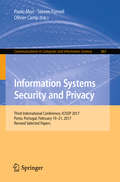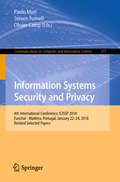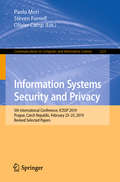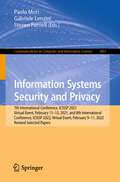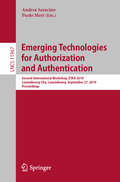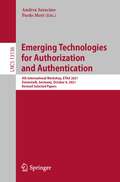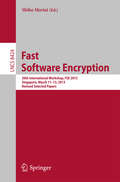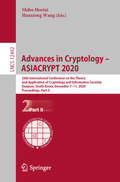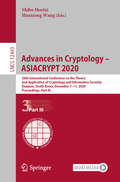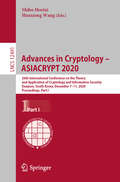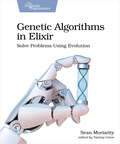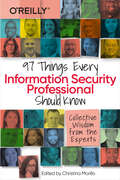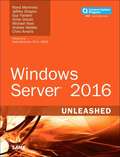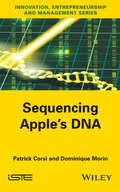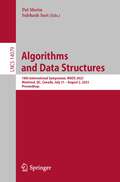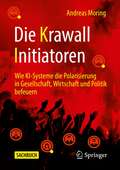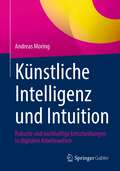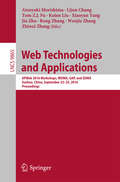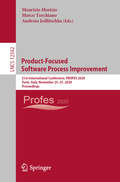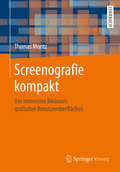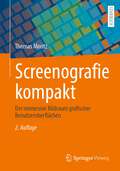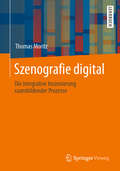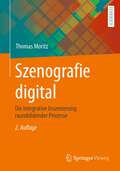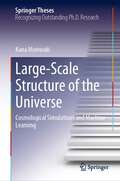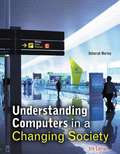- Table View
- List View
Information Systems Security and Privacy: Third International Conference, ICISSP 2017, Porto, Portugal, February 19-21, 2017, Revised Selected Papers (Communications in Computer and Information Science #867)
by Paolo Mori Steven Furnell Olivier CampThis book constitutes the revised selected papers of the Third International Conference on Information Systems Security and Privacy, ICISSP 2017, held in Porto, Portugal, in February 2017. The 13 full papers presented were carefully reviewed and selected from a total of 100 submissions. They are dealing with topics such as vulnerability analysis and countermeasures, attack patterns discovery and intrusion detection, malware classification and detection, cryptography applications, data privacy and anonymization, security policy analysis, enhanced access control, and socio-technical aspects of security.
Information Systems Security and Privacy: 4th International Conference, ICISSP 2018, Funchal - Madeira, Portugal, January 22-24, 2018, Revised Selected Papers (Communications in Computer and Information Science #977)
by Paolo Mori Steven Furnell Olivier CampThis book constitutes the revised selected papers of the Third International Conference on Information Systems Security and Privacy, ICISSP 2018, held in Funchal - Madeira, Portugal, in January 2018.The 15 full papers presented were carefully reviewed and selected from a total of 71 submissions. They are dealing with topics such as data and software security; privacy and confidentiality; mobile systems security; biometric authentication; information systems security and privacy; authentication, privacy and security models; data mining and knowledge discovery; phishing; security architecture and design analysis; security testing; vulnerability analysis and countermeasures; web applications and services.
Information Systems Security and Privacy: 5th International Conference, ICISSP 2019, Prague, Czech Republic, February 23-25, 2019, Revised Selected Papers (Communications in Computer and Information Science #1221)
by Paolo Mori Steven Furnell Olivier CampThis book constitutes the revised selected papers of the 5th International Conference on Information Systems Security and Privacy, ICISSP 2019, held in Prague, Czech Republic, in February 2019. The 19 full papers presented were carefully reviewed and selected from a total of 100 submissions. The papers presented in this volume address various topical research, including new approaches for attack modelling andprevention, incident management and response, and user authentication andaccess control, as well as business and human-oriented aspects such as data pro-tection and privacy, and security awareness.
Information Systems Security and Privacy: 7th International Conference, ICISSP 2021, Virtual Event, February 11–13, 2021, and 8th International Conference, ICISSP 2022, Virtual Event, February 9–11, 2022, Revised Selected Papers (Communications in Computer and Information Science #1851)
by Paolo Mori Gabriele Lenzini Steven FurnellThis book includes extended and revised versions of selected papers from the 7th and 8th edition of the International Conference on Information Systems Security and Privacy (ICISSP 2021 and ICISSP 2022). ICISSP 2021 and 2022 was held as an online event due to the Covid-19 pandemic, from February 11–13, 2021 and February 9–11, 2022. respectively.The 6 full papers included in this book were carefully reviewed and selected from 217 submissions. The ICISSP 2021 and 2022 book contains extended and revised version of proceedings papers dealing with information systems security and privacy.
Emerging Technologies for Authorization and Authentication: Second International Workshop, ETAA 2019, Luxembourg City, Luxembourg, September 27, 2019, Proceedings (Lecture Notes in Computer Science #11967)
by Paolo Mori Andrea SaracinoThis book constitutes the proceedings of the Second International Workshop on Emerging Technologies for Authorization and Authentication, ETAA 2019, held in Luxembourg, in September 2019. The 10 full papers presented in this volume were carefully reviewed and selected from numerous submissions. They focus on new techniques for biometric and behavioral based authentication, authentication and authorization in the IoT and in distributed systems in general, techniques for strengthen password based authentication and for dissuading malicious users from stolen password reuse, an approach for discovering authentication vulnerabilities in interconnected accounts, and strategies to optimize the access control decision process in the Big Data scenario.
Emerging Technologies for Authorization and Authentication: 4th International Workshop, ETAA 2021, Darmstadt, Germany, October 8, 2021, Revised Selected Papers (Lecture Notes in Computer Science #13136)
by Paolo Mori Andrea SaracinoThis book constitutes the proceedings of the 4th International Workshop on Emerging Technologies for Authorization and Authentication, ETAA 2021, held in Darmstadt, Germany, on October 8, 2021. The workshop was co-located with ESORICS 2021. The 11 full papers presented in this volume were carefully reviewed and selected from 14 submissions. The workshop presents new techniques for biometric and behavioral based authentication, authentication and authorization in the IoT and in distributed systems in general, including smart home environment.
Fast Software Encryption
by Shiho MoriaiThis book constitutes the thoroughly refereed post-conference proceedings of the 20th International Workshop on Fast Software Encryption, held in Singapore, March 11-13, 2013. The 30 revised full papers presented were carefully reviewed and selected from 97 initial submissions. The papers are organized in topical sections on block ciphers, lightweight block ciphers, tweakable block ciphers, stream ciphers, hash functions, message authentication codes, provable security, implementation aspects, lightweight authenticated encryption, automated cryptanalysis, Boolean functions.
Advances in Cryptology – ASIACRYPT 2020: 26th International Conference on the Theory and Application of Cryptology and Information Security, Daejeon, South Korea, December 7–11, 2020, Proceedings, Part II (Lecture Notes in Computer Science #12492)
by Shiho Moriai Huaxiong WangThe three-volume proceedings LNCS 12491, 12492, and 12493 constitutes the proceedings of the 26th International Conference on the Theory and Application of Cryptology and Information Security, ASIACRYPT 2020, which was held during December 7-11, 2020. The conference was planned to take place in Daejeon, South Korea, but changed to an online format due to the COVID-19 pandemic.The total of 85 full papers presented in these proceedings was carefully reviewed and selected from 316 submissions. The papers were organized in topical sections as follows: Part I: Best paper awards; encryption schemes.- post-quantum cryptography; cryptanalysis; symmetric key cryptography; message authentication codes; side-channel analysis. Part II: public key cryptography; lattice-based cryptography; isogeny-based cryptography; quantum algorithms; authenticated key exchange. Part III: multi-party computation; secret sharing; attribute-based encryption; updatable encryption; zero knowledge; blockchains and contact tracing.
Advances in Cryptology – ASIACRYPT 2020: 26th International Conference on the Theory and Application of Cryptology and Information Security, Daejeon, South Korea, December 7–11, 2020, Proceedings, Part III (Lecture Notes in Computer Science #12493)
by Shiho Moriai Huaxiong WangThe three-volume proceedings LNCS 12491, 12492, and 12493 constitutes the proceedings of the 26th International Conference on the Theory and Application of Cryptology and Information Security, ASIACRYPT 2020, which was held during December 7-11, 2020. The conference was planned to take place in Daejeon, South Korea, but changed to an online format due to the COVID-19 pandemic.The total of 85 full papers presented in these proceedings was carefully reviewed and selected from 316 submissions. The papers were organized in topical sections as follows: Part I: Best paper awards; encryption schemes.- post-quantum cryptography; cryptanalysis; symmetric key cryptography; message authentication codes; side-channel analysis. Part II: public key cryptography; lattice-based cryptography; isogeny-based cryptography; quantum algorithms; authenticated key exchange. Part III: multi-party computation; secret sharing; attribute-based encryption; updatable encryption; zero knowledge; blockchains and contact tracing.
Advances in Cryptology – ASIACRYPT 2020: 26th International Conference on the Theory and Application of Cryptology and Information Security, Daejeon, South Korea, December 7–11, 2020, Proceedings, Part I (Lecture Notes in Computer Science #12491)
by Shiho Moriai Huaxiong WangThe three-volume proceedings LNCS 12491, 12492, and 12493 constitutes the proceedings of the 26th International Conference on the Theory and Application of Cryptology and Information Security, ASIACRYPT 2020, which was held during December 7-11, 2020. The conference was planned to take place in Daejeon, South Korea, but changed to an online format due to the COVID-19 pandemic.The total of 85 full papers presented in these proceedings was carefully reviewed and selected from 316 submissions. The papers were organized in topical sections as follows: Part I: Best paper awards; encryption schemes.- post-quantum cryptography; cryptanalysis; symmetric key cryptography; message authentication codes; side-channel analysis. Part II: public key cryptography; lattice-based cryptography; isogeny-based cryptography; quantum algorithms; authenticated key exchange. Part III: multi-party computation; secret sharing; attribute-based encryption; updatable encryption; zero knowledge; blockchains and contact tracing.
Genetic Algorithms in Elixir: Solve Problems Using Evolution
by Sean MoriarityFrom finance to artificial intelligence, genetic algorithms are a powerful tool with a wide array of applications. But you don't need an exotic new language or framework to get started; you can learn about genetic algorithms in a language you're already familiar with. Join us for an in-depth look at the algorithms, techniques, and methods that go into writing a genetic algorithm. From introductory problems to real-world applications, you'll learn the underlying principles of problem solving using genetic algorithms. Evolutionary algorithms are a unique and often overlooked subset of machine learning and artificial intelligence. Because of this, most of the available resources are outdated or too academic in nature, and none of them are made with Elixir programmers in mind. Start from the ground up with genetic algorithms in a language you are familiar with. Discover the power of genetic algorithms through simple solutions to challenging problems. Use Elixir features to write genetic algorithms that are concise and idiomatic. Learn the complete life cycle of solving a problem using genetic algorithms. Understand the different techniques and fine-tuning required to solve a wide array of problems. Plan, test, analyze, and visualize your genetic algorithms with real-world applications. Open your eyes to a unique and powerful field - without having to learn a new language or framework. What You Need: You'll need a macOS, Windows, or Linux distribution with an up-to-date Elixir installation.
97 Things Every Information Security Professional Should Know: Collective Wisdom From The Experts
by Christina MorilloWhether you're searching for new or additional opportunities, information security can be vast and overwhelming. In this practical guide, author Christina Morillo introduces technical knowledge from a diverse range of experts in the infosec field. Through 97 concise and useful tips, you'll learn how to expand your skills and solve common issues by working through everyday security problems.You'll also receive valuable guidance from professionals on how to navigate your career within this industry. How do you get buy-in from the C-suite for your security program? How do you establish an incident and disaster response plan? This practical book takes you through actionable advice on a wide variety of infosec topics, including thought-provoking questions that drive the direction of the field.Continuously Learn to Protect Tomorrow's Technology--Alyssa ColumbusFight in Cyber Like the Military Fights in the Physical--Andrew HarrisKeep People at the Center of Your Work--Camille StewartInfosec Professionals Need to Know Operational Resilience--Ann JohnsonTaking Control of Your Own Journey--Antoine MiddletonSecurity, Privacy, and Messy Data Webs: Taking Back Control in Third-Party Environments--Ben BrookEvery Information Security Problem Boils Down to One Thing--Ben SmithFocus on the WHAT and the Why First, Not the Tool--Christina Morillo
Windows Server 2016 Unleashed (Unleashed Ser.)
by Rand Morimoto Jeffrey Shapiro Guy Yardeni Omar Droubi Michael Noel Andrew Abbate Chris AmarisThis is the most comprehensive and realistic guide to Windows Server 2016 planning, design, prototyping, implementation, migration, administration, and support. Extensively updated, it contains unsurpassed independent and objective coverage of Windows Server 2016’s key innovations, from the cloud and containers to security and mobility. <P><P>Windows Server 2016 Unleashed reflects the authors’ extraordinary experience implementing Windows Server 2016 in large-scale environments since its earliest alpha releases. Microsoft MVP Rand Morimoto and colleagues fully address all aspects of deploying and operating Windows Server 2016, including Active Directory, networking, application services, security, administration, business continuity, virtualization, optimization, and troubleshooting. You’ll find up-to-the-minute coverage of new features ranging from Storage Spaces Direct to Cluster-Aware Updating, and Dynamic Access Control to Nano Server. <P><P>Valuable for Windows pros at all levels, this book will be indispensable especially for intermediate-to-advanced level professionals seeking expert, in-depth solutions. Every chapter contains tips, tricks, best practices, and lessons learned from actual deployments—practical help for solving real problems. <P><P>Detailed information on how to: <ul> <li>Take full advantage of key Windows Server 2016 innovations Plan, prototype, install, migrate to, and deploy Windows Server 2016 and Server Core</li> <li>Design a modern Windows Server Active Directory, from OUs and infrastructure to Federated Forests and Lightweight Directories Deliver reliable networking services: DNS, WINS, DNSSEC, DHCP, IPv, IPAM, and IIS</li> <li>Systematically harden server-level security</li> <li>Protect data in transit with PKI, certificates, rights management, and IPsec encryption</li> <li>Safely provide appropriate remote and mobile access for your users</li> <li>Efficiently administer, automate, maintain, and document Windows Server production environments</li> <li>Control Windows devices centrally with Group Policies and Policy Management</li> <li>Implement advanced fault tolerance, clustering, and other business continuity features</li> <li>Optimize, tune, and debug Windows Server, and plan for growth Leverage integrated application services, including SharePoint and Hyper-V</li> <P><P>In addition, this book is part of InformIT’s Content Update Program, which provides content updates for major technology improvements! As significant updates are made to WIndows Server 2016, sections of this book will be updated or new sections will be added to match the updates to the technologies. As updates become available, they will be delivered to you via a free Web Edition of this book, which can be accessed with any Internet connection.
Sequencing Apple's DNA
by Dominique Morin Patrick CorsiThis book aims to extract the "molecular genes" leading to craziness! Geniuses are the ones who are "crazy enough to think they can change the world" and boldly go where no one has gone before. Where no past habit and usage are available, there is no proof of viability, as nobody has done it yet, or even imagined it, and no roadmap for guidance or market study has come up with it. The authors call upon Leonardo Da Vinci, the Renaissance genius, who as strange as it seems, shared many traits of personality with that of Steve Jobs, in terms of the ways of performing. Da Vinci helps in understanding Jobs, and hence Apple, with his unique way of designing radically novel concepts, which were actually quite crazy for his time. In order to shed light on a special creative posture, the indomitable sense of specifying undecidable objects - a hallmark of the late Steve Jobs - is what led the authors to match it with a specific design innovation theory. A real theory, backed by solid mathematical proof, exists and can account for the business virtue of a prolific ability to move into unknown crazy fields! The authors postulate that, by bringing the power of C-K theory to crack open a number of previous observations made about Apple's methods, it is possible to identify most of the genes of this company. The authors analyze how and why an Apple way of doing business is radically different from standard business practices and why it is so successful. Genes are a measure of the entity at hand and can encourage past business education routine approaches, then become transferable across the spectrum of the socio-economic world.
Algorithms and Data Structures: 18th International Symposium, WADS 2023, Montreal, QC, Canada, July 31 – August 2, 2023, Proceedings (Lecture Notes in Computer Science #14079)
by Pat Morin Subhash SuriThis book constitutes the refereed proceedings of the 18th International Symposium on Algorithms and Data Structures, WADS 2023, held during July 31-August 2, 2023. The 47 regular papers, presented in this book, were carefully reviewed and selected from a total of 92 submissions. They present original research on the theory, design and application of algorithms and data structures.
Die Krawall Initiatoren: Wie KI-Systeme die Polarisierung in Gesellschaft, Wirtschaft und Politik befeuern
by Andreas MoringEine zunehmende Polarisierung der Gesellschaft, identitäre Absolutismen, ein Neo-Feudalismus in digitalen Märkten, das Versagen unseres Bildungssystems, eine neue chinesisch-amerikanische Weltordnung und nicht zuletzt der Umgang mit dem Klimawandel: Alle großen Fragen unserer Zukunft führen früher oder später zu Künstlicher Intelligenz. Als Grund und Quelle dieser Entwicklungen. Und auch als der Schlüssel zu ihrer Lösung. Dieses Buch erklärt, wo diese Zusammenhänge liegen und wie die Wege zur Lösung aussehen müssen.
Künstliche Intelligenz und Intuition: Robuste und nachhaltige Entscheidungen in digitalen Arbeitswelten
by Andreas MoringKünstliche Intelligenz ist in unserem Alltag angekommen. Anwendung findet KI ebenso bereits in unterschiedlichen Branchen wie der Logistik, Medizin, Finanz- oder Landwirtschaft. Auch das ist ein Zeichen für einen grundlegenden technologischen Wandel mit umfangreichen Folgen und Effekten. Generative KI – also jene, die etwas scheinbar aus sich selbst heraus hervorbringen kann, wie beispielsweise ChatGPT oder Midjourney – führt Menschen im Sinne des Wortes sichtbar vor Augen, dass viele unserer Tätigkeiten, die wir unter „Arbeit“ oder unserem „Job“ subsumieren von KI übernommen werden könnten. Wie sollte also eine Arbeitsteilung zwischen KI-Systemen und Menschen aussehen, die ihren jeweiligen einzigartigen Kompetenzen gerecht wird und robuste und nachhaltige Entscheidungen fördert? Dieses Buch gibt einen Überblick über die Technologien und Prinzipien Künstlicher Intelligenz sowie die Einführung von KI-Technologien in Unternehmen und die damit verbundenen Change-Prozesse. Es werden die aktuell wichtigsten Anwendungsfelder von Künstlicher Intelligenz in unterschiedlichen Branchen und Industrien beschrieben sowie zahlreiche Beispiele zur nachhaltigen KI-Nutzung und zum Aufbau notwendiger Kompetenzen. Außerdem wird die menschliche Intuition dargestellt und analysiert. Hierbei wird immer wieder Bezug auf Ähnlichkeiten und Unterschiede genommen, um Künstliche Intelligenz (Artificial Intelligence) und menschliche Intuition (Archaic Intellience) ihren Domänen entsprechend zu entwickeln und damit zu resilienten, nachhaltigen Strategien und Entscheidungen zu gelangen.
Web Technologies and Applications
by Atsuyuki Morishima Rong Zhang Wenjie Zhang Lijun Chang Tom Z. J Fu Kuien Liu Xiaoyan Yang Jia Zhu Zhiwei ZhangThis book constitutes the refereed proceedings of three workshops held at the 18th Asia-Pacific Web Conference, APWeb 2016, in Suzhou, China, in September 2016: the Second International Workshop on Web Data Mining and Applications, WDMA 2016, the First International Workshop on Graph Analytics and Query Processing, GAP 2016, and the First International Workshop on Spatial-temporal Data Management and Analytics, SDMA 2016. The 27 full papers included in this book were carefully reviewed and selected from 37 submissions. The goal of these workshops is to promote the new research directions and applications, especially on web data, graph data, and spatial-temporal data management and analytics.
Product-Focused Software Process Improvement: 21st International Conference, PROFES 2020, Turin, Italy, November 25–27, 2020, Proceedings (Lecture Notes in Computer Science #12562)
by Maurizio Morisio Marco Torchiano Andreas JedlitschkaThis book constitutes the refereed proceedings of the 21st International Conference on Product-Focused Software Process Improvement, PROFES 2020, held in Turin, Italy, in November 2020. Due to COVID-19 pandemic the conference was held virtually. The 19 revised full papers and 3 short papers presented were carefully reviewed and selected from 68 submissions. The papers cover a broad range of topics related to professional software development and process improvement driven by product and service quality needs. They are organized in topical sections on Agile Software Development.
Screenografie kompakt: Der immersive Bildraum grafischer Benutzeroberflächen
by Thomas MoritzDieses Buch behandelt die Screenografie von grafischen Benutzeroberflächen basierend auf einem didaktisch strukturierten Lehrprogramm, dessen Kapitel inhaltlich aufeinander aufbauen und jeweils in einem zusammenfassenden Fazit enden. Nach einer einführenden thematischen Motivation werden wahrnehmungspsychologische und kommunikationswissenschaftliche Grundlagen des Systemischen Designs erläutert, dessen Spezifik für die systematische Entwicklung grafischer Benutzeroberflächen essentiell ist. Im Kontext immersiver Raumnutzung wird u.a. illustriert, wie ein Screen morphologisch in kleinere geometrische Einheiten unterteilbar ist, die als visuelles Ganzes die ideale Basis für ein visuelles Gestaltungsraster bilden, welches den immersiven Bildraum strukturiert und organisiert. Es werden nutzerspezifische Farbgebungen für ein visuelles Ambiente aufgezeigt, das einem speziellen Nutzernaturell entspricht, da es auf Erfahrungen mit natürlichen Umgebungen basiert und über alle geografischen und ethnologischen Grenzen hinweg stimuliert und zur interaktiven Nutzung motiviert.
Screenografie kompakt: Der immersive Bildraum grafischer Benutzeroberflächen
by Thomas MoritzDieses Lehrprogramm zur systematischen Gestaltung eines interaktiv nutzbaren Bildschirms (Screen) erläutert wahrnehmungspsychologische und kommunikationswissenschaftliche Grundlagen, die für das Systemische Design grafischer Benutzeroberflächen (Graphical User Interfaces) relevant sind. Im Kontext interaktiver Raumnutzung wird illustriert, wie die Bildschirmfläche morphologisch in Form eines visuellen Gestaltungsrasters (Visual Design Pattern) zu gliedern ist, das den immersiven Bildraum der grafischen Benutzeroberfläche strukturiert und die interaktive Nutzung erleichtert. Es werden mögliche Farbkombinationen für ein visuelles Ambiente definiert, deren Wirkungsweise auf natürlichen Erfahrungswerten basiert und somit einem speziellen Nutzernaturell entspricht, dessen Charakteristika weltweit identisch sind.
Szenografie digital: Die integrative Inszenierung raumbildender Prozesse
by Thomas MoritzIm Buch wird im Kontext individueller Rezipientenpartizipation und Nutzerimmersion erläutert, welche Wahrnehmungsaspekte der performativen Raumbildung immanent sind und warum integratives Inszenieren sie effektiver macht. Integratives Inszenieren erweitert als Bestandteil der Screenografie interaktiv nutzbarer Informations- und Kommunikationssysteme das szenografische Berufsbild und ist für die systematische Entwicklung von grafischen Benutzeroberflächen im Systemischen Design essentiell.
Szenografie digital: Die integrative Inszenierung raumbildender Prozesse
by Thomas MoritzIm Buch wird im Kontext individueller Rezipientenpartizipation und Nutzerimmersion erläutert, welche Wahrnehmungsaspekte der performativen Raumbildung immanent sind und warum integratives Inszenieren sie effektiver macht. Integratives Inszenieren erweitert als Bestandteil der Screenografie interaktiv nutzbarer Informations- und Kommunikationssysteme das szenografische Berufsbild und ist für die systematische Entwicklung von grafischen Benutzeroberflächen im Systemischen Design essentiell.
Large-Scale Structure of the Universe: Cosmological Simulations and Machine Learning (Springer Theses)
by Kana MoriwakiLine intensity mapping (LIM) is an observational technique that probes the large-scale structure of the Universe by collecting light from a wide field of the sky. This book demonstrates a novel analysis method for LIM using machine learning (ML) technologies. The author develops a conditional generative adversarial network that separates designated emission signals from sources at different epochs. It thus provides, for the first time, an efficient way to extract signals from LIM data with foreground noise. The method is complementary to conventional statistical methods such as cross-correlation analysis. When applied to three-dimensional LIM data with wavelength information, high reproducibility is achieved under realistic conditions. The book further investigates how the trained machine extracts the signals, and discusses the limitation of the ML methods. Lastly an application of the LIM data to a study of cosmic reionization is presented. This book benefits students and researchers who are interested in using machine learning to multi-dimensional data not only in astronomy but also in general applications.
Understanding Computers in a Changing Society
by Deborah MorleyUnderstanding Computers in a Changing Society gives the students a classic introduction to computer concepts and societal issues, delivering content that is relevant to today's career-focused student.
